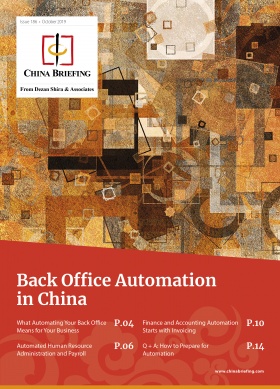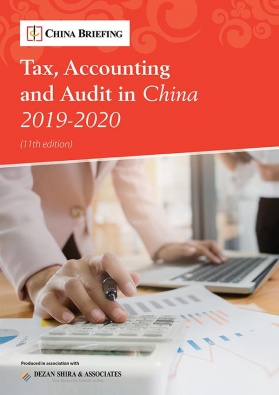EU Businesses in China Look to Mitigate Trade War Impact: EuCham 2019 Survey
- More European companies are making long-term strategic changes to their business operations to mitigate the impact of what has become a prolonged US-China trade war.
- Many US- and China- based suppliers of surveyed companies have felt pressure to raise prices.
- While some EU companies have consciously tried to avoid passing costs downstream, more businesses have reported diversifying suppliers to maneuver the tariffs across the US, China borders.
- Many European firms unable to offset the raised tariffs have opted to maintain their prices despite US border tariffs increasing the final costs to the consumer.
A growing number of European companies in China are making strategic adjustments to overcome challenges emerging out of the protracted US-China trade war, according to a Trade War Survey published by the European Union Chamber of Commerce (EuCham) in China.
Released on October 10, 2019, the Trade War Survey combines data from EuCham’s dedicated surveys conducted in September this year and last year as well as the annual Business Confidence Survey in January 2019 – covering 174, 193, and 585 responses, respectively.
What do the survey findings say?
Latest findings show that compared to January 2019, the overall sentiment among European firms has not changed – with over 30 percent of those surveyed holding a negative outlook towards US-China trade tensions.
However, more European companies are viewing the trade war as symptomatic of endemic international trade grievances and are taking long-term decisions in front of the moving tariff targets. Non-action in the hope that the trade war will run its course is no longer considered viable by most of the firms surveyed.
In terms of shifting supply chains, around 70 percent of the respondents said their supply chains had been disrupted to some extent. Of these, 10 percent were severely or completely disrupted.
More US- and China-based suppliers are also finding it tougher to absorb the costs of the tariffs themselves, which have also escalated as the trade war has dragged on. Some firms with a reputation for their high-quality products have started passing on the cost burden to consumers through price increases. Notably, around one quarter of the surveyed companies’ suppliers were affected by US tariffs, 19 percent of which admitted to price increases.
Nevertheless, about 60 percent of the European businesses surveyed admitted they were still holding off on any price changes, despite increased sourcing costs from US-based suppliers. The ratio of European companies passing costs downstream dropped 10 percent and the ratio of those keeping their prices the same nearly doubled, compared to the figures in January 2019.
This can be explained by the fact that more companies have successfully taken various strategies to circumvent the tariffs like changing their suppliers, redirecting their global production around the US-China ‘border’, taking advantage of the ‘first sale rule’, or adopting a ‘China plus one’ model.
On the other side, the number of European companies exporting goods from China to the US and thus affected by US tariffs climbed from 25 percent to 35 percent. However, new companies hit by fresh tariffs appeared to be less exposed; most of them had only one to 10 percent of their exports affected by the tariffs.
Still, according to the latest survey, a higher number of European companies are choosing to maintain their prices despite US tariffs raising their product’s final cost.
This is because they cannot offset the 25 percent tariffs or are confident their products will not be easily replaced in the American market. Yet, more European exporters are adjusting their supply chains to source from Europe or other third markets to reduce their exposure to US tariffs.
Interestingly, several firms have also reported increasing their investment in China – looking to diversify their market reach and target Chinese consumers (in China, for China), while three percent and eight percent of respondents have taken took drastic steps to relocate production out of the US and China, respectively.
Finally, 15 percent of the respondents reported they were delaying investment or expansion decisions.
How to read the findings
By far, the US-China trade war has tariffed all possible types of imports – from China, the tariffs have disproportionately affected electronics, electrical appliances, machinery, and furniture and from the US, agricultural goods.
Despite the growing likelihood that the two countries will sign an interim trade deal at the Asia-Pacific Economic Cooperation (APEC) summit in Chile in November, it appears that more companies, including European businesses, view the trade conflict as long-term and are consequently exploring backup plans to avoid dealing with more uncertainties.
Christopher Liptau, Assistant Manager at Dezan Shira and Associates told China Briefing that “due to rising labor costs in China, legal compliances, or other reasons, some European companies were already considering relocation or diversifying their supply chains.”
“Not all companies leave China because of the trade war. But the trade war and connected complications seem to increase the speed of those who might want to get out or diversify their operations to avoid negative impacts.”
Further, having more operational flexibility when adjusting supply chains, such as by adopting a China plus one model, might help firms manage immediate cost concerns and reduce their future risk exposure.
In effect, the US-China trade war may bring good news to a lot of European businesses. The EU is now the top export destination for China, followed by ASEAN and the US.
In the first half of 2019, the gap between China’s exports to the EU and the US had widened, with the ASEAN region surpassing the US as China’s second major export destination.
According to the General Administration of the Customs of China (GACC), China’s exports to the EU totaled RMB 2.3 trillion (US$320 billion), up 11.2 percent, accounting for 15.7 percent of China’s total exports. During the same period, China’s exports to the ASEAN totaled RMB 1.98 trillion (US$280 billion), up 10.5 percent, and accounting for 13.5 percent of China’s total exports. China’s exports to the US totaled RMB 1.75 trillion (US$250 billion), down nine percent, and accounting for 12 percent of China’s total exports.
China is also accelerating its imports from and exports to Belt and Road (BRI) countries, which accounted for 28.9 percent of the country’s total imports and exports, up 9.7 percent in the first half of 2019.
Riccardo Benussi, Deputy Regional Manager at Dezan Shira and Associates’ Shanghai office explains that these numbers show that “European companies are actually seeing more opportunities to do business as China is looking more favorably towards the EU, even though some countries have bilateral concerns with China like Germany. ”
According to one SCMP report, Germany’s Chancellor Angela Merkel has promised to put EU-China relations to the fore when the country occupies the EU’s rotating presidency next year.
Inviting China’s President Xi Jinping to attend the summit scheduled in Leipzig next September is a chance for the EU to present a “united front” when dealing with China. “What the EU wants is that China recognize it as a whole economy at all given times”, Riccardo added.
About Us
China Briefing is produced by Dezan Shira & Associates. The firm assists foreign investors throughout Asia from offices across the world, including in Dalian, Beijing, Shanghai, Guangzhou, Shenzhen, and Hong Kong. Readers may write to china@dezshira.com for more support on doing business in China.
- Previous Article Back Office Automation in China – New Issue of China Briefing Magazine
- Next Article Despite Social Issues, Hong Kong is Holding Up as a Vibrant China Business Hub








